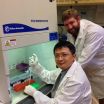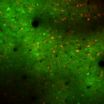(Press-News.org) A new study exposes the risk of nutritional deficiencies in severely obese teens – both those who had weight loss surgery and those who did not.
At least five years after undergoing gastric bypass surgery, teens and young adults maintained significant weight loss but were at risk of nutritional deficiencies, particularly low iron, mild anemia and low vitamin D. The study also found low iron and low vitamin D in severely obese teens who did not undergo weight loss surgery. Those who didn't have surgery also had low levels of protein in their blood.
The Cincinnati Children's Hospital Medical Center study will be presented Sunday, May 4, at the annual meeting of the Pediatric Academic Societies in Vancouver, Canada. The study is believed to be the first study to compare the nutritional status of severely obese teens who did not undergo weight loss surgery to those who did have surgery.
"We knew there were nutritional difficulties in teens who had undergone bariatric surgery, but everyone thought it was primarily the surgery that caused these problems since gastric bypass excludes the portion of the small intestine where many nutrients, especially iron, are most absorbed," says Stavra Xanthakos, MD, medical director the Surgical Weight Loss Program for Teens at Cincinnati Children's and a co-author of the study. "What this shows us is that nutritional deficiencies occur even in teens who don't undergo surgery. Severely obese patients should be screened for nutritional deficiencies, regardless of whether they've undergone weight loss surgery."
The researchers studied 79 obese teens who either received weight loss surgery or were evaluated but didn't receive surgery. The patients were evaluated between 2001 and 2007 and contacted to participate in the study between 2011 and 2014.
Eight years on average after surgery, these patients had experienced "durable and significant" weight loss, about 28 percent, says Dr. Xanthakos. Those who didn't receive surgery had not lost weight.
INFORMATION:
The principal investigator of the study, Thomas Inge, M.D., who is surgical director of the Surgical Weight Loss Program for Teens, received salary support for the study via a grant from Ethicon Endo-Surgery.
About Cincinnati Children's
Cincinnati Children's Hospital Medical Center ranks third in the nation among all Honor Roll hospitals in U.S.News and World Report's 2013 Best Children's Hospitals ranking. It is ranked #1 for cancer and in the top 10 for nine of 10 pediatric specialties. Cincinnati Children's, a non-profit organization, is one of the top three recipients of pediatric research grants from the National Institutes of Health, and a research and teaching affiliate of the University of Cincinnati College of Medicine. The medical center is internationally recognized for improving child health and transforming delivery of care through fully integrated, globally recognized research, education and innovation. Additional information can be found at http://www.cincinnatichildrens.org. Connect on the Cincinnati Children's blog, via Facebook and on Twitter.
Study exposes risk of nutritional deficiencies in obese teens
2014-05-05
ELSE PRESS RELEASES FROM THIS DATE:
Lean patients with fatty liver disease have higher mortality rate
2014-05-04
Chicago, IL (May 4, 2014) — Despite being of a healthier weight, lean patients with nonalcoholic fatty liver disease (NAFLD) have a higher overall mortality rate than patients with NAFLD who are overweight or obese, according to new research presented today at Digestive Disease Week® (DDW). In addition to finding higher mortality rates, an international team of researchers found that lean patients [a body mass index (BMI) less than 25] with NAFLD were more likely to be male, non-Caucasian and to have lower rates of chronic conditions, such as diabetes and hypertension. ...
Arizona Sate University scientists take steps to unlock the secrets to the fountain of youth
2014-05-04
ASU scientists, together with collaborators from the Chinese Academy of Sciences in Shanghai, have published today, in Nature Structural and Molecular Biology, a first of its kind atomic level look at the enzyme telomerase that may unlock the secrets to the fountain of youth.
Telomeres and the enzyme telomerase have been in the medical news a lot recently due to their connection with aging and cancer. Telomeres are found at the ends of our chromosomes and are stretches of DNA which protect our genetic data, make it possible for cells to divide, and hold some secrets as ...
Study unveils new approach to treating brittle bone disease
2014-05-04
HOUSTON – (May 4, 2014) – Researchers at Baylor College of Medicine have identified a new approach to treating brittle bone disease, a congenital disorder that results in fragile bones that break easily.
The study, published in the current issue of the journal Nature Medicine, showed that excessive activity of an important signaling protein in the matrix of the bone called transforming growth factor beta is associated with the cause of the disease.
"There are many genetic causes of brittle bone disease in children and adults," said Dr. Brendan Lee, professor of molecular ...
New method for measuring the temperature of nanoscale objects discovered
2014-05-04
Temperature measurements in our daily life are typically performed by bringing a thermometer in contact with the object to be measured. However, measuring the temperature of nanoscale objects is a much more tricky task due to their size - up to a thousand times smaller than the width of a human hair.
Pioneering research, published in Nature Nanotechnology, has now developed a method to accurately measure the surface temperature of nanoscale objects when they have a different temperature than their environment. A team led by Dr Janet Anders at the University of Exeter ...
New insight may help predict volcanic eruption behavior
2014-05-04
VIDEO:
Using friction experiments University of Liverpool scientists have shown that frictional melting plays a role in determining how a volcano will erupt.
Click here for more information.
A new discovery in the study of how lava dome volcanoes erupt may help in the development of methods to predict how a volcanic eruption will behave, say scientists at the University of Liverpool.
Volcanologists at the University have discovered that a process called frictional melting plays ...
Functioning of aged brains and muscles in mice made younger
2014-05-04
Cambridge, MA, May 4 - Harvard Stem Cell Institute (HSCI) researchers have shown that a protein they previously demonstrated can make the failing hearts in aging mice appear more like those of young health mice, similarly improves brain and skeletal muscle function in aging mice.
In two separate papers given early online release today by the journal Science – which is publishing the papers this coming Friday, Professors Amy Wagers and Lee Rubin, of Harvard's Department of Stem Cell and Regenerative Biology (HSCRB), report that injections of a protein known as GDF11, which ...
New study sheds light on global warming trends
2014-05-04
TALLAHASSEE, Fla. — New research by a team of Florida State University scientists shows the first detailed look at global land surface warming trends over the last 100 years, illustrating precisely when and where different areas of the world started to warm up or cool down.
The research indicates that the world is indeed getting warmer, but historical records show that it hasn't happened everywhere at the same rate.
And that new information even took scientists by surprise.
"Global warming was not as understood as we thought," said Zhaohua Wu, an assistant professor ...
Motor cortex shown to play active role in learning movement patterns
2014-05-04
Skilled motor movements of the sort tennis players employ while serving a tennis ball or pianists use in playing a concerto, require precise interactions between the motor cortex and the rest of the brain. Neuroscientists had long assumed that the motor cortex functioned something like a piano keyboard.
"Every time you wanted to hear a specific note, there was a specific key to press," says Andrew Peters, a neurobiologist at UC San Diego's Center for Neural Circuits and Behavior. "In other words, every specific movement of a muscle required the activation of specific ...
Taking the lead out of a promising solar cell
2014-05-04
Northwestern University researchers are the first to develop a new solar cell with good efficiency that uses tin instead of lead perovskite as the harvester of light. The low-cost, environmentally friendly solar cell can be made easily using "bench" chemistry -- no fancy equipment or hazardous materials.
"This is a breakthrough in taking the lead out of a very promising type of solar cell, called a perovskite," said Mercouri G. Kanatzidis, an inorganic chemist with expertise in dealing with tin. "Tin is a very viable material, and we have shown the material does work ...
Study points to potential revision of treatment guidelines for bleeding ulcers
2014-05-04
Chicago, IL (May 4, 2014) — The current standard of care for managing patients who receive endoscopic treatment for bleeding ulcers should be replaced by an equally safe and less costly alternative that is more comfortable for patients, according to new research presented today at Digestive Disease Week® (DDW). Researchers at the Yale University School of Medicine compared the current recommended care plan — delivering an initial dose of proton pump inhibitor (PPI) followed by continuous PPI infusion — to a regimen using only intermittent PPI therapy, which was found to ...




